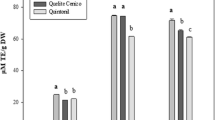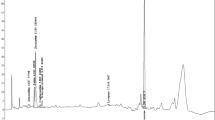Abstract
The aim of this investigation was to find a proper harvesting period and establishing fern number, which effects the spear yield, bioactive compounds and antioxidant activities of Asparagus officinalis L. Spears were harvested at 2, 4, and 6 weeks after sprouting. Control for comparison was used without harvest. Spears and total yield increased with prolonged spear harvest period. In harvest of 6 weeks long optimum spear yield was the highest and fern numbers were 5 ~ 8. Bioactive compounds (polyphenols, flavonoids, flavanols, tannins and ascorbic acid) and the levels of antioxidant activities by ferric-reducing/antioxidant power (FRAP) and cupric reducing antioxidant capacity (CUPRAC) assays in asparagus ethanol extracts significantly differed in the investigated samples and were the highest at 6 weeks harvest period (P < 0.05). The first and the second segments from the tip significantly increased with the increase of catalase (CAT). It was interesting to investigate in vitro how human serum albumin (HSA) interacts with polyphenols extracted from investigated vegetables. Therefore the functional properties of asparagus were studied by the interaction of polyphenol ethanol extracts with HSA, using 3D- FL. In conclusion, antioxidant status (bioactive compounds, binding and antioxidant activities) improved with the harvesting period and the first segment from spear tip. Appropriate harvesting is effective for higher asparagus yield and its bioactivity.

Similar content being viewed by others
References
Chin CK, Garrison SA (2008) Functional elements from asparagus for human health. Acta Hort, Proc. XIth IS on Asparagus, Editors J.H. Mulder, P.J.M. Lavrijsen, 776:219–225, ISBN-13: 9789066056701
Papadopoulou PP, Siomos AS, Dogras CC (2003) Comparison of textural and compositional attributes of green and white asparagus produced under commercial conditions. Plant Foods Hum Nutr 58:1–9
Maeda T, Kakuta H, Sonoda T, Motoki S, Ueno R, Suzuki T, Oosawa K (2005) Antioxidation capacities of extracts from green, purple, and white asparagus spears related to polyphenol concentration. HortSci 40:1221–1224, ISSN 2327–9834
Rodríguez R, Jaramillo S, Rodríguez G, Espejo JA, Guillén R, Fernández-Bolaños J, Heredia A, Jiménez A (2005) Antioxidant activity of ethanolic extracts from several asparagus cultivars. J Agric Food Chem 53:5212–5217
Shao Y, Chin CH, Ho CH, Ma W, Garrison SA, Huang MT (1996) Antitumor activity of the crude saponins obtained from asparagus. Cancer Lett 104:31–36
Shou S, Lu G, Huang X (2007) Seasonal variations in nutritional components of green asparagus using the mother fern cultivation. Sci Horticult 112:251–257
Wang J, Liu Y, Zhao J, Zhang W, Pang X (2013) Saponins extracted from by-product of Asparagus officinalis L. suppress tumour cell migration and invasion through targeting rho GTPase signaling pathway. J Sci Food Agric 93:1492–1498
Hartung AC, Nair MG, Putnam AR (1990) Isolation and characterization of phytotoxic compounds from asparagus (Asparagus officinalis L.) roots. J Chem Ecol 16:1707–1718
Sun T, Powers JR, Tang J (2007) Evaluation of the antioxidant activity of asparagus, broccoli and their juices. Food Chem 105:101–106
Ku YG, Woolley DJ, Ahn SJ, Lee JH (2010) Affecting Asparagus officinalis shoot and root growth characteristics with CPPU foliar sprays and soil drenching. Kor J Hort Sci Technol 28:167–171
Inoue K, Shigematsu T, Ozaki Y (2008) Effect of training the mother fern and time of pruning secondary branching on the yield and size of spears in semi-forced green asparagus (Asparagus officinalis. L.). Hort Res 7:91–95
Fluentes-Alventosa JM, Jaramillo-Carmona S, Rodríguez-Gutiérrez G, Guillén-Bejarano R, Jiménez-Araujo A, Fernández-Bolaños J, Rodríguez-Arcos R (2013) Preparation of bioactive extracts from asparagus by-product. Food Bioprod Process 91:74–82
Amaro Lopez MA, Zurera Cosano G, Moreno Rojas R, Garcia-Gimeno RM (1996) Mineral content modifications during ripening of asparagus (Asparagus officinalis, L.). Foods Hum Nutr 49:13–26. doi:10.1007/BF01092518
Zheng H, Lu H (2011) Effect of microwave pretreatment on the kinetics of ascorbic acid degradation and peroxidase inactivation in different parts of green asparagus (Asparagus officinalis L.) during water blanching. Food Chem 128:1087–1093
Sun T, Tang J, Power JR (2005) Effect of pectolytic enzyme preparations on the phenolic composition and antioxidant activity of asparagus juice. J Agric Food Chem 53:42–48
Mishra NP, Mishra RK, Singhal GS (1993) Changes in the activities of anti-oxidant enzymes during exposure of intact wheat leaves to strong visible light at different temperatures in the presence of protein synthesis inhibitors. Plant Physiol 102:903–910
Chen GX, Asada K (1989) Ascorbate peroxidase in tea leaves: occurrence of two isozymes and the differences in their enzymatic and molecular properties. Plant Cell Physiol 30:987–998, JSPP © 1989, ISSN 1471–9053
Egley GH, Paul RN, Vaughn KC, Duke SO (1983) Role of peroxidase in the development of water-impermeable seed coats in Sida spinosa L. Plant 157:224–232
Gorinstein S, Haruenkit R, Poovarodom S, Vearasilp S, Ruamsuke P, Namiesnik J, Leontowicz M, Leontowicz H, Suhaj M, Sheng GP (2010) Some analytical assays for the determination of bioactivity of exotic fruits. Phytochem Anal 21:355–362
Singleton VL, Orthofer R, Lamuela-Raventos RM (1999) Analysis of total phenols and other oxidation substrates and antioxidants by means of Folin-Ciocalteu reagent. Methods Enzym 299:152–178
Arnous A, Makris DP, Kefalas P (2001) Effect of principal polyphenolic components in relation to antioxidant characteristics of aged red vines. J Agric Food Chem 49:5736–5742
Park YS, Im MH, Ham KS, Kang SG, Park YK, Namiesnik J, Leontowicz H, Leontowicz M, Katrich E, Gorinstein S (2013) Nutritional and pharmaceutical properties of bioactive compounds in organic and conventional growing kiwifruit. Plant Foods Hum Nutr 68:57–64
Ozyurek M, Guclu K, Bektasoglu B, Apak R (2007) Spectrophotometric determination of ascorbic acid by the modified CUPRAC method with extractive separation of flavonoids–La (III) complexes. Anal Chim Acta 588:88–95
Benzie IFF, Strain JJ (1996) The ferric reducing ability of plasma (FRAP) as a measure of antioxidant power: the FRAP assay. Anal Biochem 239:70–76
Apak R, Guclu K, Ozyurek M, Karademir SE (2004) Novel total antioxidant capacity index for dietary polyphenols and vitamins C and E, using their cupric ion reducing capability in the presence of neocuproine: CUPRAC method. J Agric Food Chem 52:7970–7981
Cermeño P, Calado S, Rubio V, Ortega FR (2008) Extending the asparagus production harvest period in southern Spain. Acta Hort, Proc. XIth IS on Asparagus, Editors J.H. Mulder, P.J.M. Lavrijsen, 776: 55–62, ISBN-13: 9789066056701
Paschold PJ, Artelt B, Hermann G (2002) Influence of harvest duration on yield and quality of asparagus. Acta Hort, Proc. Xth IS on Asparagus, Editor A. Uragami, 589: 65–71, ISBN-13: 9789066057968
Wilson DR, Sinton SM, Wright CE (1999) Influence of time of spear harvest on root system resources during the annual growth cycle of asparagus. Acta Hort, Proc. 9 th Int Asparagus Symp, Editor B. Benson, 479: 313–319, ISBN-13: 978-90-66057-91-3
Nindo CI, Sun T, Wang SW, Tanga J, Powers JR (2003) Evaluation of drying technologies for retention of physical quality and antioxidants in asparagus (Asparagus officinalis, L.). Lebensm Wiss Technol 36:507–516
Martins D, Barros L, Carvalho AM, Ferreira ICFR (2011) Nutritional and in vitro antioxidant properties of edible wild greens in Iberian Peninsula traditional diet. Food Chem 125:488–494
Tiveron AP, Melo PS, Bergamaschi KB, Vieira TMFS, Regitano-d’Arce MAB, Alencar SM (2012) Antioxidant activity of Brazilian vegetables and its relation with phenolic composition. Intern J Mol Sci 13:8943–8957
Kumar BP, Toshiyuki M, Takao I, Haruo S (2002) Changes in storage quality and shelf life of green asparagus over an extended harvest season. Postharv Biol Tech 26:323–328
Acknowledgments
This work was supported by a grant (PJ009423022014) from the Rural Development Administration, Republic of Korea. The authors are thankful to Dr. Elena Katrich (School of Pharmacy, Hebrew University of Jerusalem) for her technical assistance in determination of binding activity.
Conflict of Interest
We don’t have any conflict of interest.
Author information
Authors and Affiliations
Corresponding author
Rights and permissions
About this article
Cite this article
Lee, J.W., Lee, J.H., Yu, I.H. et al. Bioactive Compounds, Antioxidant and Binding Activities and Spear Yield of Asparagus officinalis L.. Plant Foods Hum Nutr 69, 175–181 (2014). https://doi.org/10.1007/s11130-014-0418-9
Published:
Issue Date:
DOI: https://doi.org/10.1007/s11130-014-0418-9




